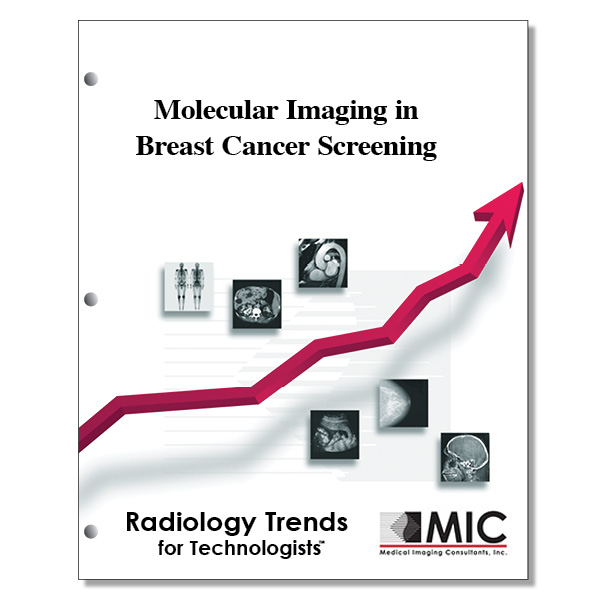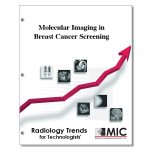

Molecular Imaging in Breast Cancer Screening
A description of how molecular breast imaging is being used alongside other technologic advances in breast imaging for breast cancer screening.
Course ID: Q00541 Category: Radiology Trends for Technologists Modalities: Mammography, MRI, Nuclear Medicine, Sonography2.25 |
Satisfaction Guarantee |
$24.00
- Targeted CE
- Outline
- Objectives
Targeted CE per ARRT’s Discipline, Category, and Subcategory classification for enrollments starting after March 18, 2024:
[Note: Discipline-specific Targeted CE credits may be less than the total Category A credits approved for this course.]
Breast Sonography: 1.50
Procedures: 1.50
Pathology: 1.50
Mammography: 1.50
Procedures: 1.50
Mammographic Positioning, Special Needs, and Imaging Procedures: 1.50
Magnetic Resonance Imaging: 1.50
Procedures: 1.50
Body: 1.50
Nuclear Medicine Technology: 2.25
Safety: 0.75
Radiation Physics, Radiobiology, and Regulations: 0.75
Procedures: 1.50
Other Imaging Procedures: 1.50
Registered Radiologist Assistant: 1.50
Procedures: 1.50
Thoracic Section: 1.50
Sonography: 1.50
Procedures: 1.50
Superficial Structures and Other Sonographic Procedures: 1.50
Outline
- Introduction
- Primary Screening
- Need for Supplemental Screening after DBT
- Supplemental Screening of High-Risk Women with Dense Breasts
- Supplemental Screening of Average-Risk Women with Dense Breasts
- Decision Algorithm for Supplemental Screening
- Screening Workflow and Patient Management
- Implementing MBI in Clinical Practice
- Case Studies
- Supplemental Screening for Dense/Complex Mammograms
- Case 1
- Case 2
- Case 3
- Case 4
- High-Risk Screening and MR Imaging Contraindications
- Case 5
- Case 6
- MBI Diagnostic Use for Problem Solving
- Case 7
- Case 8
- Case 9
- False Positives
- Case 10
- Case 11
- Case 12
- Supplemental Screening for Dense/Complex Mammograms
- Conclusion
Objectives
Upon completion of this course, students will:
- know the authors’ primary imaging modality for breast cancer screening
- know a particular patient population for which detecting breast cancer can be a challenge for mammography
- know the expectations for routine supplemental breast cancer screening
- understand the decision to switch from 2D digital mammography to DBT as the primary imaging modality for women presenting for breast cancer screenings
- be familiar with the decision to continue with supplemental screening of women with dense breasts even after conversion to DBT for primary screening
- recognize the advantages of MR imaging with IV gadolinium as a supplemental screening method for high-risk women with dense breasts
- know why MR imaging with IV gadolinium is not suitable as a supplemental screening technique for all patients
- identify the patient populations for which MR imaging would be recommended as an effective screening tool
- be familiar with the guidelines supporting MR for adjunct breast cancer screening
- be aware of the reasons mentioned in the article why MBI might be offered as an alternative imaging solution to MR as a supplemental breast cancer screening method
- know the origins for the basis of MBI, due to incidental tracer uptake in breast tumors
- understand why the 99mTc-sestamibi radiotracer is not affected by anatomic characteristics such as density or surgical distortion
- be familiar with the limitations of camera detectors in early 99mTc-sestamibi breast imaging
- know how the sensitivity of gamma cameras has been enhanced in recent years
- be familiar with the relative radiation dose risk of MBI
- know the effects of adding MBI to digital mammography versus mammography alone
- understand how adding MBI as an adjunct breast screening technique compares to the addition of other adjunct screening techniques
- be familiar with the ACR’s BI-RADS classifications of breast density
- know the next screening step for women who have been objectively scored as having dense breasts on the BI-RADS scoring system
- know which patient populations would be recommended for either MR or MBI imaging as adjunct screening after mammography
- understand the type of density scoring provided by breast density assessment software, as compared to a radiologist’s interpretation
- know what should be reported to the referring physician in the final mammography report
- know this site’s screening recommendation to high-risk women with dense breasts
- be familiar with the roles of the scheduling personnel at this site once a patient has been recommended for MBI
- know the menstrual cycle phase when MBI is to be performed
- know when MBI imaging should commence after radiotracer injection
- be familiar with what should be considered for documentation in an MBI report
- know why biennial MBI supplemental screening is recommended in non-high-risk women
- know when positive findings at MBI should be evaluated with targeted ultrasound
- know the roles of the various personnel when implementing MBI in clinical practice
- be familiar with the various entities for which education was identified as being crucial to the maintenance and continuation of the clinical site’s MBI program
- know why the patient in Case 1 was recommended for supplemental screening with MBI
- know the aspect of MBI which reassures both radiologists and patients in cases where a mammogram is too dense for accurate interpretation and MBI is clearly negative
- know why the patient in Case 8 was recommended for MBI
- understand why the patient in Case 11 was recommended for supplemental screening
